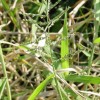 Paragrass (also referred to as Californiagrass) is thought to have been introduced into Florida sometime in the late 1870s as a forage plant. The semiaquatic grass is a native of tropical Africa, and today it is established in both hemispheres in tropical and subtropical regions as a highly palatable fodder. The grass is established in regions of poorly drained soils and along freshwater shorelines in Alabama, Florida, Hawaii, Maryland, Oregon, South Carolina, and Texas. It is an extremely aggressive competitor that can displace many shoreline emergent plants and plants in cultivated or disturbed sites associated with moist soil. Paragrass becomes readily established in wet soils along shorelines where it can form large monocultures. This 4-page fact sheet was written by L. T. Markle, B. A. Sellers, and W. A. Overholt, and published by the UF Department of Agronomy, April 2013.
Paragrass (also referred to as Californiagrass) is thought to have been introduced into Florida sometime in the late 1870s as a forage plant. The semiaquatic grass is a native of tropical Africa, and today it is established in both hemispheres in tropical and subtropical regions as a highly palatable fodder. The grass is established in regions of poorly drained soils and along freshwater shorelines in Alabama, Florida, Hawaii, Maryland, Oregon, South Carolina, and Texas. It is an extremely aggressive competitor that can displace many shoreline emergent plants and plants in cultivated or disturbed sites associated with moist soil. Paragrass becomes readily established in wet soils along shorelines where it can form large monocultures. This 4-page fact sheet was written by L. T. Markle, B. A. Sellers, and W. A. Overholt, and published by the UF Department of Agronomy, April 2013.
http://edis.ifas.ufl.edu/ag375
Category: Ecosystems & Species
Cypress looper Anacamptodes pergracilis (Hulst) (Insecta: Lepidoptera: Geometridae) (EENY303/IN986)
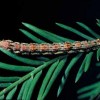 Anacamptodes pergracilis (Hulst), commonly known as the cypress looper, drew considerable attention in late summer of 1980 with the unexpected defoliation of nearly 28,000 ha of cypress trees in USFS-NPS Big Cypress National Preserve (Collier and Monroe counties). Currently, cypress looper populations are at low levels, even in the Fisheating Creek (Glades County) area, a perennial generator of significant cypress looper defoliation over the past 20 years. This 3-page fact sheet was written by Wayne N. Dixon, and published by the UF Department of Entomology and Nematology, April 2013.
Anacamptodes pergracilis (Hulst), commonly known as the cypress looper, drew considerable attention in late summer of 1980 with the unexpected defoliation of nearly 28,000 ha of cypress trees in USFS-NPS Big Cypress National Preserve (Collier and Monroe counties). Currently, cypress looper populations are at low levels, even in the Fisheating Creek (Glades County) area, a perennial generator of significant cypress looper defoliation over the past 20 years. This 3-page fact sheet was written by Wayne N. Dixon, and published by the UF Department of Entomology and Nematology, April 2013.
http://edis.ifas.ufl.edu/in986
UF is celebrating Bug Week
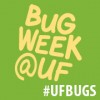 We at University of Florida want to provide you with a beginner-friendly yet science-based look at Florida’s bugs, with emphasis on the species that Florida residents and visitors often encounter. Some are Good Bugs. Some are Bad Bugs. And a whole lot are Bugly Bugs. Follow #UFBugs on Twitter, or vist the website at
We at University of Florida want to provide you with a beginner-friendly yet science-based look at Florida’s bugs, with emphasis on the species that Florida residents and visitors often encounter. Some are Good Bugs. Some are Bad Bugs. And a whole lot are Bugly Bugs. Follow #UFBugs on Twitter, or vist the website at
http://bugs.ufl.edu
Biting midges, no-see-ums Culicoides spp. (Insecta: Diptera: Ceratopogonidae) (EENY349/IN626)
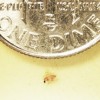 Biting midges can be a nuisance to campers, fishermen, hunters, hikers, gardeners, and others who spend time outdoors during early morning and evenings, and even during the daytime on cloudy days when winds are calm. They will readily bite humans; the bites are irritating, painful, and can cause long-lasting painful lesions for some people. A common observation upon experiencing a bite from this insect is that something is biting, but the person suffering can not see what it is. This 4-page fact sheet was written by C. Roxanne Connelly, and published by the UF Department of Entomology and Nematology, April 2013.
Biting midges can be a nuisance to campers, fishermen, hunters, hikers, gardeners, and others who spend time outdoors during early morning and evenings, and even during the daytime on cloudy days when winds are calm. They will readily bite humans; the bites are irritating, painful, and can cause long-lasting painful lesions for some people. A common observation upon experiencing a bite from this insect is that something is biting, but the person suffering can not see what it is. This 4-page fact sheet was written by C. Roxanne Connelly, and published by the UF Department of Entomology and Nematology, April 2013.
http://edis.ifas.ufl.edu/in626
Cornsilk Fly (suggested common name), Euxesta stigmatias Loew (Insecta: Diptera: Otitidae) (EENY224/IN381)
 ‘Cornsilk flies’ are attractive, medium to dark metallic green to black colored flies with distinctive wing patterns and wing flapping behavior. They are commonly found throughout Florida’s agricultural communities. Their normally saprophytic life style belies their destructive nature when it comes to their preference for sweet corn ears. Four species of ‘cornsilk flies’ are known to attack corn in Florida: Chaetopsis massyla (Walker), Euxesta annonae (Fabricius), Euxesta eluta Loew, and Euxesta stigmatias Loew. This 8-page fact sheet was written by Gregg S. Nuessly and John L. Capinera, and published by the UF Department of Entomology and Nematology, April 2013. #UFBugs
‘Cornsilk flies’ are attractive, medium to dark metallic green to black colored flies with distinctive wing patterns and wing flapping behavior. They are commonly found throughout Florida’s agricultural communities. Their normally saprophytic life style belies their destructive nature when it comes to their preference for sweet corn ears. Four species of ‘cornsilk flies’ are known to attack corn in Florida: Chaetopsis massyla (Walker), Euxesta annonae (Fabricius), Euxesta eluta Loew, and Euxesta stigmatias Loew. This 8-page fact sheet was written by Gregg S. Nuessly and John L. Capinera, and published by the UF Department of Entomology and Nematology, April 2013. #UFBugs
http://edis.ifas.ufl.edu/in381
The mexican lac scale Tachardiella mexicana (Comstock) (Hemiptera: Kerriidae) (EENY552/IN990)
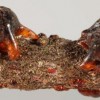 The Mexican lac scale is native to Mexico and Texas, but populations have been established in Florida. Adult female scales produce a high-domed ‘test’ or shell with four to six lobe-like projections that anchor the test to the plant surface. The test is hard and glossy with a reddish-orange tint around the edges, and darker toward the center. In some specimens, white string-like wax fiber extrusions project from the dorsum of the test, but these may break off. This 3-page fact sheet was written by Ian Stocks, and published by the UF Department of Entomology and Nematology, April 2013.
The Mexican lac scale is native to Mexico and Texas, but populations have been established in Florida. Adult female scales produce a high-domed ‘test’ or shell with four to six lobe-like projections that anchor the test to the plant surface. The test is hard and glossy with a reddish-orange tint around the edges, and darker toward the center. In some specimens, white string-like wax fiber extrusions project from the dorsum of the test, but these may break off. This 3-page fact sheet was written by Ian Stocks, and published by the UF Department of Entomology and Nematology, April 2013.
http://edis.ifas.ufl.edu/in990
Mealybug Vryburgia trionymoides (DeLotto) (Pseudococcidae) (EENY553/IN991)
 On several occasions in 2011, succulents for sale at retail stores in Florida were found with infestations of the mealybug Vryburgia trionymoides DeLotto. A traceback revealed that the succulents originated in California, where this mealybug is known as an occasional greenhouse pest. Specimens intercepted or found in retail stores often were well-hidden in the axillary region near the stem, making detection more challenging. An untreated infestation can kill a plant, there are no published reports of economic losses caused by this species. This 2-page fact sheet was written by Ian Stocks, and published by the UF Department of Entomology and Nematology, April 2013.
On several occasions in 2011, succulents for sale at retail stores in Florida were found with infestations of the mealybug Vryburgia trionymoides DeLotto. A traceback revealed that the succulents originated in California, where this mealybug is known as an occasional greenhouse pest. Specimens intercepted or found in retail stores often were well-hidden in the axillary region near the stem, making detection more challenging. An untreated infestation can kill a plant, there are no published reports of economic losses caused by this species. This 2-page fact sheet was written by Ian Stocks, and published by the UF Department of Entomology and Nematology, April 2013.
http://edis.ifas.ufl.edu/in991
Common Woody Plants of Florida Scrub Ecosystems (FOR305/FR373)
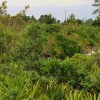 The purpose of this fact sheet is to help identify a few of the more common woody plant species found in Florida’s scrub ecosystems. In the individual plant descriptions, words that appear in bold font are considered to be key field characteristics that will aid in identification of the species. This 14-page fact sheet was written by Lynn Proenza and Michael Andreu, and published by the UF Department of School of Forest Resources and Conservation, October 2012.
The purpose of this fact sheet is to help identify a few of the more common woody plant species found in Florida’s scrub ecosystems. In the individual plant descriptions, words that appear in bold font are considered to be key field characteristics that will aid in identification of the species. This 14-page fact sheet was written by Lynn Proenza and Michael Andreu, and published by the UF Department of School of Forest Resources and Conservation, October 2012.
http://edis.ifas.ufl.edu/fr373
Citrus peelminer Marmara gulosa Guillèn and Davis (Insecta: Lepidoptera: Gracillariidae) (EENY415/IN985)
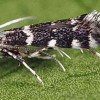 The citrus peelminer is a dark-gray moth with mottled white and brown markings and about 4 mm in length. This moth is considered native in the United States, attacking willow. It is believed that a host-shift occurred to multiple non-native plants including all varieties of citrus and cerain ornamentals, such as oleander. Citrus peelminer has been reported to occur in low numbers in Florida and at least three Marmara species have been identified in the state. Recent evaluations of an experimental pheromone lure that is still under development by researchers at the University of California, Riverside have confirmed captures of citrus peelminer (Marmara sp.) in Polk County, Florida. This 3-page fact sheet was written by Lukasz L. Stelinski, and published by the UF Department of Entomology and Nematology, April 2013.
The citrus peelminer is a dark-gray moth with mottled white and brown markings and about 4 mm in length. This moth is considered native in the United States, attacking willow. It is believed that a host-shift occurred to multiple non-native plants including all varieties of citrus and cerain ornamentals, such as oleander. Citrus peelminer has been reported to occur in low numbers in Florida and at least three Marmara species have been identified in the state. Recent evaluations of an experimental pheromone lure that is still under development by researchers at the University of California, Riverside have confirmed captures of citrus peelminer (Marmara sp.) in Polk County, Florida. This 3-page fact sheet was written by Lukasz L. Stelinski, and published by the UF Department of Entomology and Nematology, April 2013.
http://edis.ifas.ufl.edu/in985
Key to Nine Common Smilax Species of Florida (FOR307/FR375)
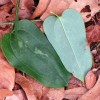 Identifying species found in Smilax the genus can be difficult because species resemble one another closely. One must be careful to use detailed descriptions in order to correctly identify a specimen. Smilax species are important because they can provide shelter and food for wildlife and have provided humans with medicine, food, and dyes. Twelve Smilax species are found in Florida. This 8-page fact sheet covers the nine more common species that one may encounter in the state. Written by Lynn Proenza and Michael Andreu, and published by the UF Department of School of Forest Resources and Conservation, January 2013.
Identifying species found in Smilax the genus can be difficult because species resemble one another closely. One must be careful to use detailed descriptions in order to correctly identify a specimen. Smilax species are important because they can provide shelter and food for wildlife and have provided humans with medicine, food, and dyes. Twelve Smilax species are found in Florida. This 8-page fact sheet covers the nine more common species that one may encounter in the state. Written by Lynn Proenza and Michael Andreu, and published by the UF Department of School of Forest Resources and Conservation, January 2013.
http://edis.ifas.ufl.edu/fr375
How Are the Reservoirs in the Apalachicola-Chattahoochee-Flint River Basin Managed? (AE497)
 Many uses of the Apalachicola-Chattahoochee-Flint river basin depend on how the US Army Corp of Engineers operates dam releases from the reservoirs when managing lake levels and downstream river flows and water levels. However, no single set of protocols equally suited to all uses and demands governs the reservoir releases. The purpose of this publication is to describe how the USACE manages reservoirs and dams in the ACF and how the waters in the basin are used. This 6-page fact sheet was written by Christopher J. Martinez, and published by the UF Department of Agricultural and Biological Engineering, March 2013.
Many uses of the Apalachicola-Chattahoochee-Flint river basin depend on how the US Army Corp of Engineers operates dam releases from the reservoirs when managing lake levels and downstream river flows and water levels. However, no single set of protocols equally suited to all uses and demands governs the reservoir releases. The purpose of this publication is to describe how the USACE manages reservoirs and dams in the ACF and how the waters in the basin are used. This 6-page fact sheet was written by Christopher J. Martinez, and published by the UF Department of Agricultural and Biological Engineering, March 2013.
http://edis.ifas.ufl.edu/ae497
Bagworm, Thyridopteryx ephemeraeformis Haworth (Insecta: Lepidoptera: Psychidae) (EENY548/IN981)
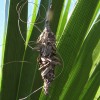 North American bagworm can feed on over 50 families of deciduous and evergreen trees and shrubs. Severe infestations can damage the aesthetics and health of host plants, especially juniper and arborvitae species. Many of the preferred host plants do not grow well below the USDA hardiness zone 8A, but due to its wide host range, high female fecundity, and method of dispersal, bagworm can still be problematic in the Florida landscape. This 5-page fact sheet was written by Brooke L. Moffis and Steven P. Arthurs, and published by the UF Department of Entomology and Nematology, March 2013.
North American bagworm can feed on over 50 families of deciduous and evergreen trees and shrubs. Severe infestations can damage the aesthetics and health of host plants, especially juniper and arborvitae species. Many of the preferred host plants do not grow well below the USDA hardiness zone 8A, but due to its wide host range, high female fecundity, and method of dispersal, bagworm can still be problematic in the Florida landscape. This 5-page fact sheet was written by Brooke L. Moffis and Steven P. Arthurs, and published by the UF Department of Entomology and Nematology, March 2013.
http://edis.ifas.ufl.edu/in981
EPA’s Endocrine Disruptor Screening Program (EDSP) (PI227)
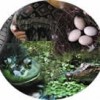 People have asked questions in recent years concerning the effects that certain chemicals may have on the endocrine system of humans and wildlife. Laboratory studies have produced evidence that show various chemicals disrupt the endocrine systems of animals. Other evidence has shown that the endocrine systems of certain fish and wildlife species have been affected by chemical contaminants. Do some of these same chemical contaminants also affect the human endocrine system? Do pesticides cause these effects? The relationship between human diseases of the endocrine system and exposure to environmental contaminants is poorly understood and controversial. This 2-page fact sheet discusses the U.S. Environmental Protection Agency’s (EPA) screening program for potential effects to the endocrine system caused by pesticide exposure. Written by F.M. Fishel, and published by the UF Department of Agronomy, March 2013.
People have asked questions in recent years concerning the effects that certain chemicals may have on the endocrine system of humans and wildlife. Laboratory studies have produced evidence that show various chemicals disrupt the endocrine systems of animals. Other evidence has shown that the endocrine systems of certain fish and wildlife species have been affected by chemical contaminants. Do some of these same chemical contaminants also affect the human endocrine system? Do pesticides cause these effects? The relationship between human diseases of the endocrine system and exposure to environmental contaminants is poorly understood and controversial. This 2-page fact sheet discusses the U.S. Environmental Protection Agency’s (EPA) screening program for potential effects to the endocrine system caused by pesticide exposure. Written by F.M. Fishel, and published by the UF Department of Agronomy, March 2013.
http://edis.ifas.ufl.edu/pi227
Blue Orchard Bee, Osmia lignaria Say (Insecta: Hymenoptera: Megachilidae) (EENY549/IN982)
 The blue orchard bee, Osmia lignaria Say (Fig. 1), is a solitary mason bee native to the west coast of the United States and Canada. It is of great interest for use as a native pollinator of fruit trees and blueberries, and is easily managed due to its favorable biological characteristics. Blue orchard bees can be purchased online for pollination, and they are shipped as pupae ready to emerge in the spring. This 4-page fact sheet was written by Alden Estep, Catherine Zettel-Nalen, and James Ellis, and published by the UF Department of Entomology and Nematology, March 2013.
The blue orchard bee, Osmia lignaria Say (Fig. 1), is a solitary mason bee native to the west coast of the United States and Canada. It is of great interest for use as a native pollinator of fruit trees and blueberries, and is easily managed due to its favorable biological characteristics. Blue orchard bees can be purchased online for pollination, and they are shipped as pupae ready to emerge in the spring. This 4-page fact sheet was written by Alden Estep, Catherine Zettel-Nalen, and James Ellis, and published by the UF Department of Entomology and Nematology, March 2013.
http://edis.ifas.ufl.edu/in982
Natural Area Weeds: Old World Climbing Fern (Lygodium microphyllum) (SSAGR21/AG122)
 Native to Africa, Asia, and Australia, Old World climbing fern (OWCF) is a newcomer to Florida that has spread at an alarming rate since its introduction. The Florida Exotic Pest Plant Council considers Old World climbing fern to be invasive. It’s also regulated by laws of the Florida Department of Agriculture and Consumer Services (FDACS) as a Florida Noxious Weed and by the United States Department of Agriculture (USDA) as a Federal Noxious Weed. It may be the most serious threat to Florida’s natural areas. This 6-page fact sheet was written by Kenneth A. Langeland and Jeffery Hutchinson, and published by the UF Department of Agronomy, February 2013.
Native to Africa, Asia, and Australia, Old World climbing fern (OWCF) is a newcomer to Florida that has spread at an alarming rate since its introduction. The Florida Exotic Pest Plant Council considers Old World climbing fern to be invasive. It’s also regulated by laws of the Florida Department of Agriculture and Consumer Services (FDACS) as a Florida Noxious Weed and by the United States Department of Agriculture (USDA) as a Federal Noxious Weed. It may be the most serious threat to Florida’s natural areas. This 6-page fact sheet was written by Kenneth A. Langeland and Jeffery Hutchinson, and published by the UF Department of Agronomy, February 2013.
http://edis.ifas.ufl.edu/ag122
Florida's Established Arthropod Weed Biological Control Agents and Their Targets (ENY853/IN779)
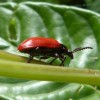 Around 5% of the plant species deliberately introduced into Florida for crop production and horticultural uses have invaded sensitive aquatic and terrestrial natural areas as well as improved pastures. One of the reasons they become invasive is they lack the natural enemies that limit their reproduction. Biological control reunites these natural enemies (usually arthropods) with their host plants to selectively weaken and suppress the invasive weeds. This 3-page fact sheet was written by J. P. Cuda and J. H. Frank, and published by the UF Department of Entomology and Nematology, October 2013.
Around 5% of the plant species deliberately introduced into Florida for crop production and horticultural uses have invaded sensitive aquatic and terrestrial natural areas as well as improved pastures. One of the reasons they become invasive is they lack the natural enemies that limit their reproduction. Biological control reunites these natural enemies (usually arthropods) with their host plants to selectively weaken and suppress the invasive weeds. This 3-page fact sheet was written by J. P. Cuda and J. H. Frank, and published by the UF Department of Entomology and Nematology, October 2013.
http://edis.ifas.ufl.edu/in779
Wildland-Urban Interface: Key Issues (FOR202/FR264)
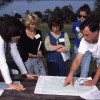 A result of the influx of new residents to the South is an expansion of urban areas into forests and other natural areas, creating areas referred to as the wildland-urban interface. Interface issues of most concern vary from state to state, but some key issues are consistent across the South. the US Forest Service conducted a series of focus groups in 2000. Key issues gleaned from those focus groups and other related sources are described in this 5-page fact sheet written by L. Annie Hermansen-Baez, Jennifer Seitz, and Martha C. Monroe, and published by the UF Department of School of Forest Resources and Conservation, February 2013.
A result of the influx of new residents to the South is an expansion of urban areas into forests and other natural areas, creating areas referred to as the wildland-urban interface. Interface issues of most concern vary from state to state, but some key issues are consistent across the South. the US Forest Service conducted a series of focus groups in 2000. Key issues gleaned from those focus groups and other related sources are described in this 5-page fact sheet written by L. Annie Hermansen-Baez, Jennifer Seitz, and Martha C. Monroe, and published by the UF Department of School of Forest Resources and Conservation, February 2013.
http://edis.ifas.ufl.edu/fr264
Grass Carp: A Fish for Biological Management of Hydrilla and Other Aquatic Weeds in Florida (BUL867/FA043)
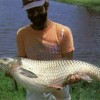 Abundant growth of aquatic plants causes serious problems in ponds, lakes, rivers, and irrigation and drainage throughout Florida. In some situations, native aquatic plants become weeds, but most often exotic plants introduced from areas outside the state flourish under the favorable growing conditions found in Florida. Long-term economical solutions to Florida’s aquatic weed problems have been elusive and there is a need for control techniques to alleviate aquatic weed problems. This 6-page fact sheet provides information on a biological method, the grass carp, for management of some of Florida’s aquatic weed problems. Written by David L. Sutton and Vernon V. Vandiver, Jr., and published by the UF Department of Fisheries and Aquatic Sciences, November 2013.
Abundant growth of aquatic plants causes serious problems in ponds, lakes, rivers, and irrigation and drainage throughout Florida. In some situations, native aquatic plants become weeds, but most often exotic plants introduced from areas outside the state flourish under the favorable growing conditions found in Florida. Long-term economical solutions to Florida’s aquatic weed problems have been elusive and there is a need for control techniques to alleviate aquatic weed problems. This 6-page fact sheet provides information on a biological method, the grass carp, for management of some of Florida’s aquatic weed problems. Written by David L. Sutton and Vernon V. Vandiver, Jr., and published by the UF Department of Fisheries and Aquatic Sciences, November 2013.
http://edis.ifas.ufl.edu/fa043
Tropical Soda Apple Leaf Beetle, Gratiana boliviana Spaeth (Insecta: Coleoptera: Chrysomelidae: Cassidinae) (EENY543/IN974)
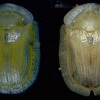 Tropical soda apple is a prickly shrub native to South America that is a major problem in pastures and conservation areas. So a multi-agency program supported the rearing, distribution, and release of more than 250,000 tropical soda apple leaf beetles across Florida from 2003 to 2011. This 4-page fact sheet was written by Rodrigo Diaz, William A. Overholt, Ken Hibbard, and Julio Medal, and published by the UF Department of Entomology and Nematology, January 2013.
Tropical soda apple is a prickly shrub native to South America that is a major problem in pastures and conservation areas. So a multi-agency program supported the rearing, distribution, and release of more than 250,000 tropical soda apple leaf beetles across Florida from 2003 to 2011. This 4-page fact sheet was written by Rodrigo Diaz, William A. Overholt, Ken Hibbard, and Julio Medal, and published by the UF Department of Entomology and Nematology, January 2013.
http://edis.ifas.ufl.edu/in974
Tips for Integrating Land and Wildlife Management: Deer in Ranchlands (WEC330/UW375)
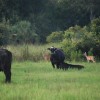 In addition to having generally low-quality foods, ranchlands often have a low diversity of food sources, further reducing the quality of habitat for deer. Ranchland management for deer should therefore focus on providing a diversity of abundant, high-quality foods. This 2-page fact sheet provides some deer habitat improvement tips that focus primarily on raising the quality of deer forage but that also will help you grow better cover by improving plant diversity and productivity. Written by William M. Giuliano, John M. Olson, and Cailey Thomas, and published by the UF Department of Wildlife Ecology and Conservation, January 2013.
In addition to having generally low-quality foods, ranchlands often have a low diversity of food sources, further reducing the quality of habitat for deer. Ranchland management for deer should therefore focus on providing a diversity of abundant, high-quality foods. This 2-page fact sheet provides some deer habitat improvement tips that focus primarily on raising the quality of deer forage but that also will help you grow better cover by improving plant diversity and productivity. Written by William M. Giuliano, John M. Olson, and Cailey Thomas, and published by the UF Department of Wildlife Ecology and Conservation, January 2013.
http://edis.ifas.ufl.edu/uw375